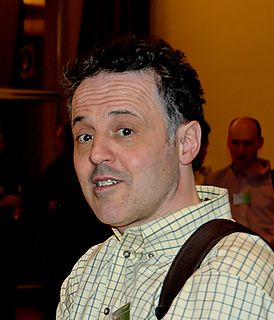Common Lisp (CL) is a dialect of the Lisp programming language, published in ANSI standard document ANSI INCITS 226-1994 (S20018). The Common Lisp HyperSpec, a hyperlinked HTML version, has been derived from the ANSI Common Lisp standard.

Lisp is a family of programming languages with a long history and a distinctive, fully parenthesized prefix notation. Originally specified in 1958, Lisp is the second-oldest high-level programming language still in common use. Only Fortran is older, by one year. Lisp has changed since its early days, and many dialects have existed over its history. Today, the best-known general-purpose Lisp dialects are Common Lisp, Scheme, Racket and Clojure.
Multiple inheritance is a feature of some object-oriented computer programming languages in which an object or class can inherit features from more than one parent object or parent class. It is distinct from single inheritance, where an object or class may only inherit from one particular object or class.

Smalltalk is an object-oriented, dynamically typed reflective programming language. It was designed and created in part for educational use, specifically for constructionist learning, at the Learning Research Group (LRG) of Xerox PARC by Alan Kay, Dan Ingalls, Adele Goldberg, Ted Kaehler, Diana Merry, Scott Wallace, and others during the 1970s.
In computer science, an object can be a variable, a data structure, a function, or a method. As regions of memory, they contain value and are referenced by identifiers.

The Common Lisp Object System (CLOS) is the facility for object-oriented programming which is part of ANSI Common Lisp. CLOS is a powerful dynamic object system which differs radically from the OOP facilities found in more static languages such as C++ or Java. CLOS was inspired by earlier Lisp object systems such as MIT Flavors and CommonLoops, although it is more general than either. Originally proposed as an add-on, CLOS was adopted as part of the ANSI standard for Common Lisp and has been adapted into other Lisp dialects such as EuLisp or Emacs Lisp.
In computer programming, a generic function is a function defined for polymorphism.
In object-oriented programming languages, a mixin is a class that contains methods for use by other classes without having to be the parent class of those other classes. How those other classes gain access to the mixin's methods depends on the language. Mixins are sometimes described as being "included" rather than "inherited".
Interlisp is a programming environment built around a version of the programming language Lisp. Interlisp development began in 1966 at Bolt, Beranek and Newman in Cambridge, Massachusetts with Lisp implemented for the Digital Equipment Corporation (DEC) PDP-1 computer by Danny Bobrow and D. L. Murphy. In 1970, Alice K. Hartley implemented BBN LISP, which ran on PDP-10 machines running the operating system TENEX. In 1973, when Danny Bobrow, Warren Teitelman and Ronald Kaplan moved from BBN to the Xerox Palo Alto Research Center (PARC), it was renamed Interlisp. Interlisp became a popular Lisp development tool for artificial intelligence (AI) researchers at Stanford University and elsewhere in the community of the Defense Advanced Research Projects Agency (DARPA). Interlisp was notable for integrating interactive development tools into an integrated development environment (IDE), such as a debugger, an automatic correction tool for simple errors, and analysis tools.
In computer science, a metaobject is an object that manipulates, creates, describes, or implements objects. The object that the metaobject pertains to is called the base object. Some information that a metaobject might define includes the base object's type, interface, class, methods, attributes, parse tree, etc. Metaobjects are examples of the computer science concept of reflection, where a system has access to its own internal structure. Reflection enables a system to essentially rewrite itself on the fly, to alter its own implementation as it executes.

Gregor Kiczales is an American computer scientist. He is currently a full time professor of computer science at the University of British Columbia in Vancouver, British Columbia, Canada. He is best known for developing the concept of aspect-oriented programming, and the AspectJ extension to the Java programming language, both of which he designed while working at Xerox PARC. He is also one of the co-authors of the specification for the Common Lisp Object System, and is the author of the book The Art of the Metaobject Protocol, along with Jim Des Rivières and Daniel G. Bobrow.
In computing, CLISP is an implementation of the programming language Common Lisp originally developed by Bruno Haible and Michael Stoll for the Atari ST. Today it supports the Unix and Microsoft Windows operating systems.
CMUCL is a free Common Lisp implementation, originally developed at Carnegie Mellon University.
In aspect and functional programming, advice describes a class of functions which modify other functions when the latter are run; it is a certain function, method or procedure that is to be applied at a given join point of a program.
Flavors, an early object-oriented extension to Lisp developed by Howard Cannon at the MIT Artificial Intelligence Laboratory for the Lisp machine and its programming language Lisp Machine Lisp, was the first programming language to include mixins. Symbolics used it for its Lisp machines, and eventually developed it into New Flavors; both the original and new Flavors were message passing OO models. It was hugely influential in the development of the Common Lisp Object System (CLOS).

Programming language theory (PLT) is a branch of computer science that deals with the design, implementation, analysis, characterization, and classification of formal languages known as programming languages. Programming language theory is closely related to other fields including mathematics, software engineering, and linguistics. There are a number of academic conferences and journals in the area.

EuLisp is a statically and dynamically scoped Lisp dialect developed by a loose formation of industrial and academic Lisp users and developers from around Europe. The standardizers intended to create a new Lisp "less encumbered by the past", and not so minimalist as Scheme. Another objective was to integrate the object-oriented programming paradigm well. It is a third-generation programming language.
LispWorks is computer software, a proprietary implementation and integrated development environment (IDE) for the programming language Common Lisp. LispWorks was developed by the UK software company Harlequin Ltd., and first published in 1989. Harlequin ultimately spun off its Lisp division as Xanalys Ltd., which took over management and rights to LispWorks. In January 2005, the Xanalys Lisp team formed LispWorks Ltd. to market, develop, and support the software.
CommonLoops is an early programming language which extended Common Lisp to include Object-oriented programming functionality and is a dynamic object system which differs from the OOP facilities found in static languages such as C++ or Java. Like New Flavors, CommonLoops supported multiple inheritance, generic functions and method combination. CommonLoops also supported multi-methods and made use of metaobjects. CommonLoops and New Flavors were the primary ancestors of CLOS. CommonLoops was supported by a portable implementation known as Portable CommonLoops (PCL) which ran on all Common Lisp implementations of the day.
Ted Kaehler is an American computer scientist known for his role in the development of several system methods. He is most noted for his contributions to the programming languages Smalltalk, Squeak, and Apple Computer's HyperCard system, and other technologies developed at Xerox PARC.






